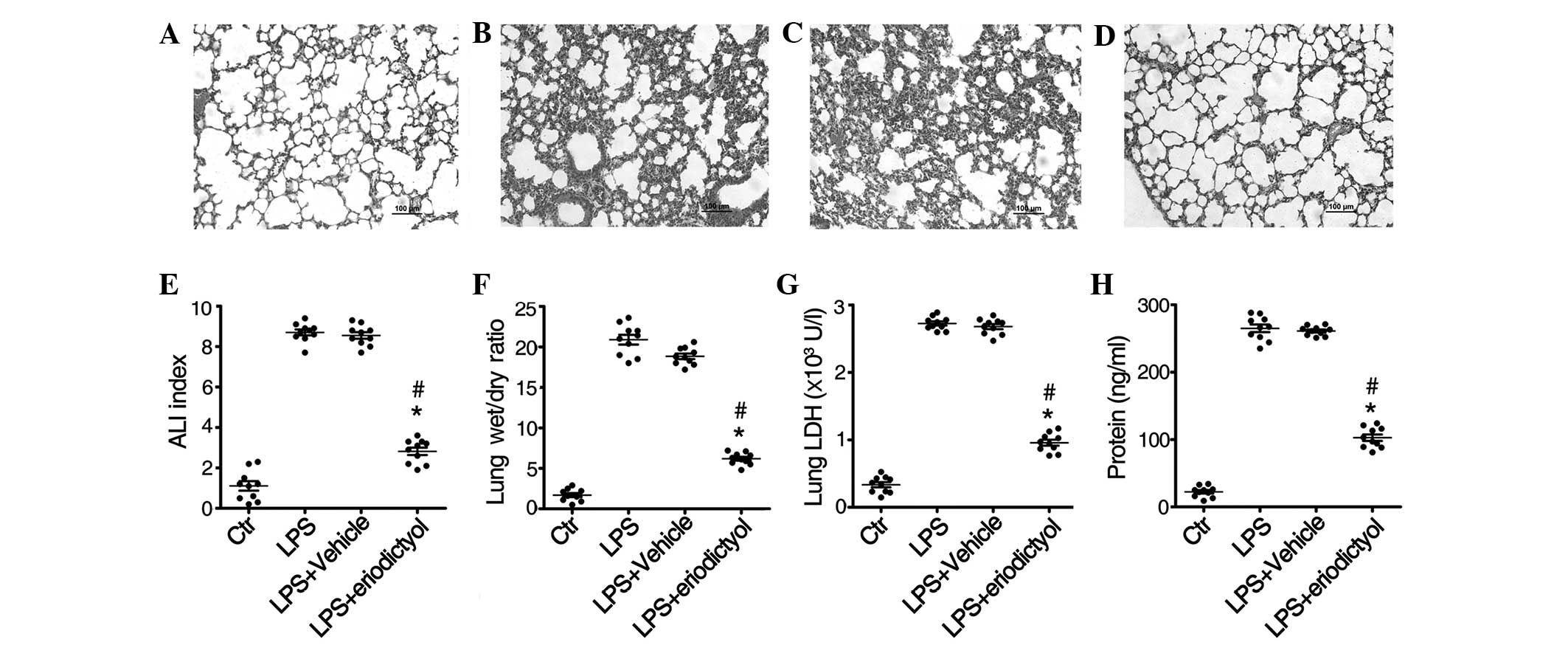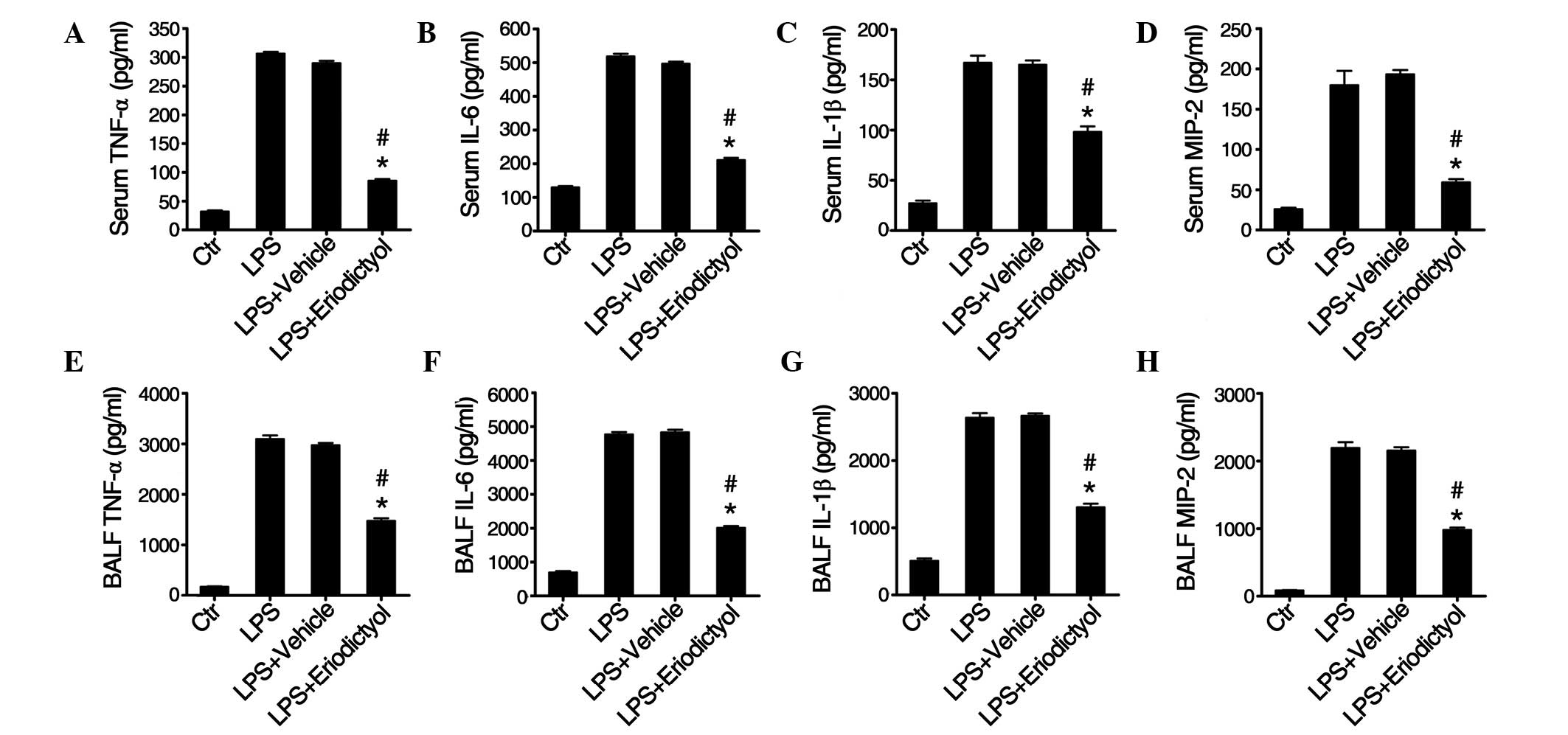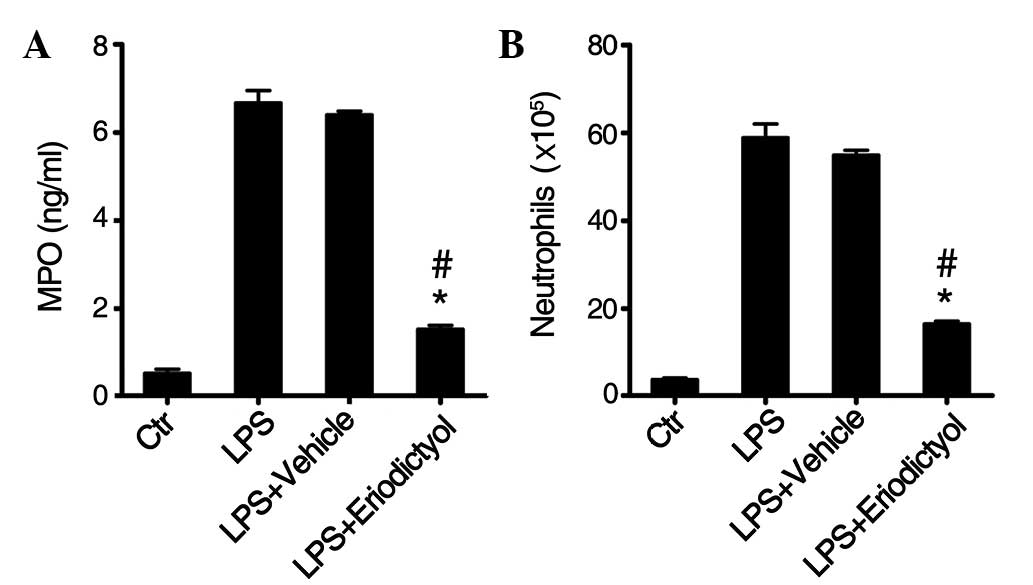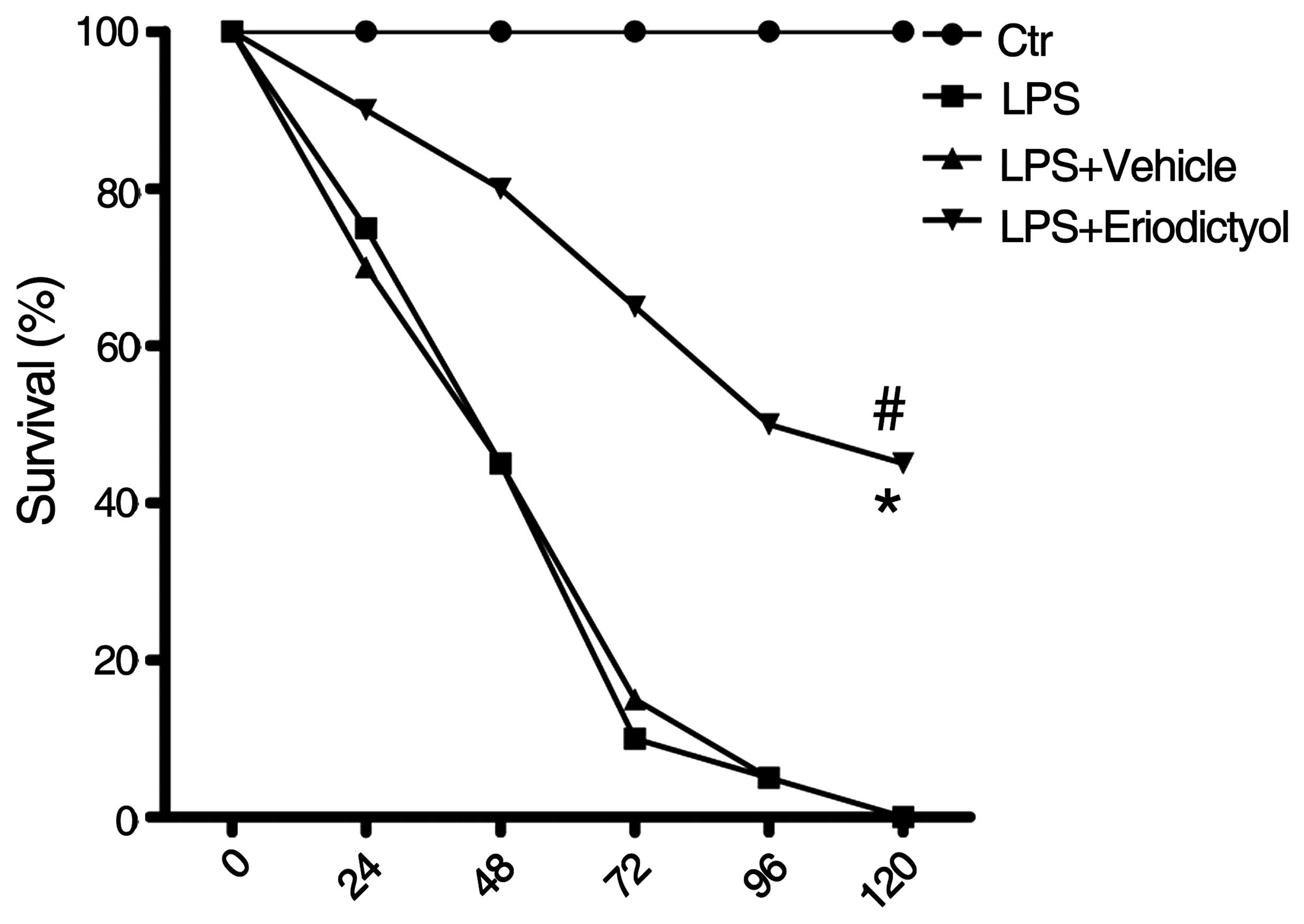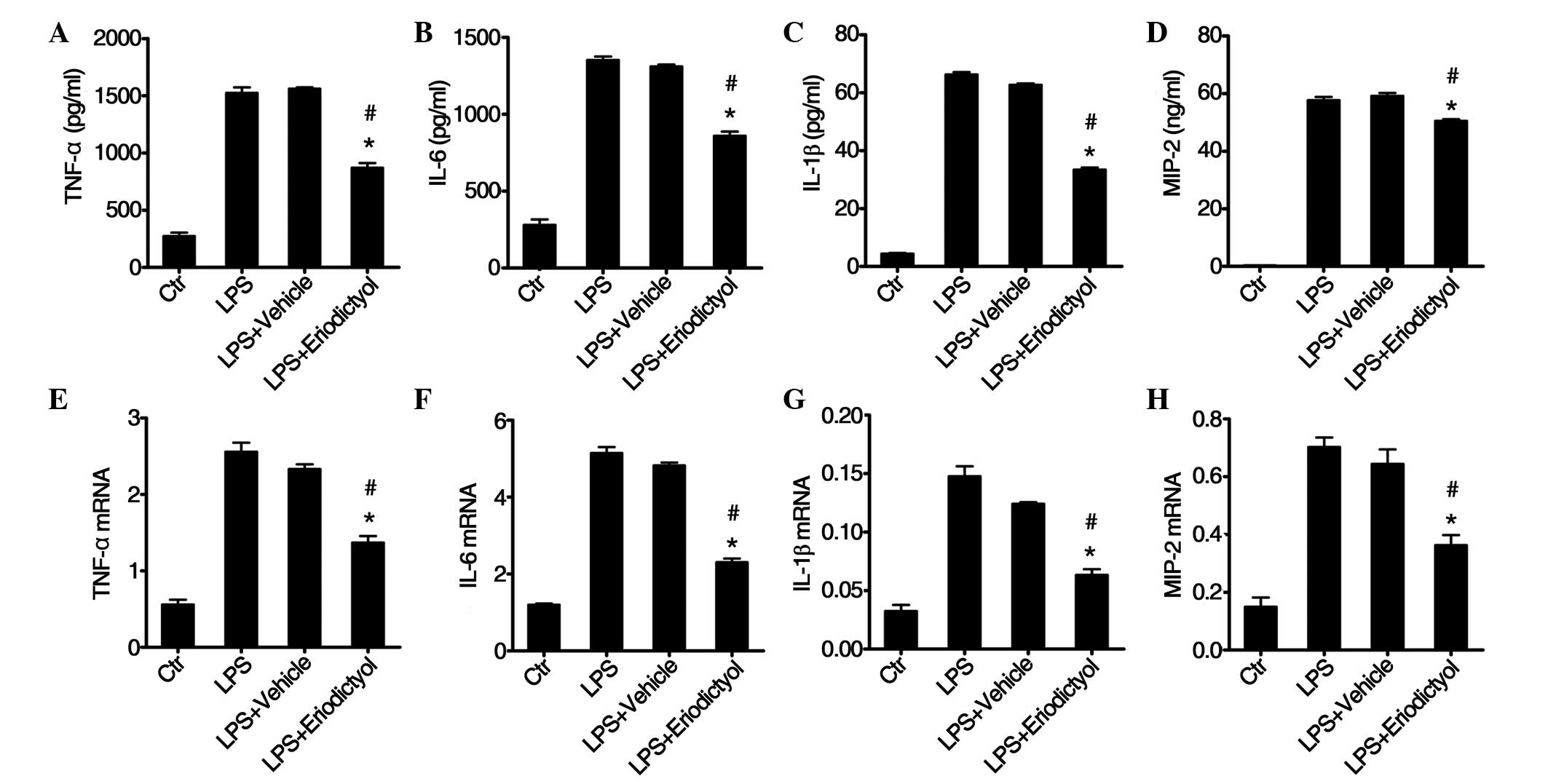|
1
|
Luh SP and Chiang CH: Acute lung
injury/acute respiratory distress syndrome (ALI/ARDS): The
mechanism, present strategies and future perspectives of therapies.
J Zhejiang Univ Sci B. 8:60–69. 2007. View Article : Google Scholar : PubMed/NCBI
|
|
2
|
Rubenfeld GD: Epidemiology of acute lung
injury. Crit Care Med. 31(Suppl): S276–S284. 2003. View Article : Google Scholar : PubMed/NCBI
|
|
3
|
Zhang X, Song K, Xiong H, Li H, Chu X and
Deng X: Protective effect of florfenicol on acute lung injury
induced by lipopolysaccharide in mice. Int Immunopharmacol.
9:1525–1529. 2009. View Article : Google Scholar : PubMed/NCBI
|
|
4
|
Ferrero-Miliani L, Nielsen OH, Andersen PS
and Girardin SE: Chronic inflammation: Importance of NOD2 and NALP3
in interleukin-1beta generation. Clin Exp Immunol. 147:227–235.
2007.PubMed/NCBI
|
|
5
|
Aderem A and Ulevitch RJ: Toll-like
receptors in the induction of the innate immune response. Nature.
406:782–787. 2000. View
Article : Google Scholar : PubMed/NCBI
|
|
6
|
Hsu H, Shu HB, Pan MG and Goeddel DV:
TRADD-TRAF2 and TRADD-FADD interactions define two distinct TNF
receptor 1 signal transduction pathways. Cell. 84:299–308. 1996.
View Article : Google Scholar : PubMed/NCBI
|
|
7
|
Karin M and Lin A: NF-kappaB at the
crossroads of life and death. Nat Immunol. 3:221–227. 2002.
View Article : Google Scholar : PubMed/NCBI
|
|
8
|
Liu J, Minemoto Y and Lin A: c-Jun
N-terminal protein kinase 1 (JNK1), but not JNK2, is essential for
tumor necrosis factor alpha-induced c-Jun kinase activation and
apoptosis. Mol Cell Biol. 24:10844–10856. 2004. View Article : Google Scholar : PubMed/NCBI
|
|
9
|
Liu J and Lin A: Wiring the cell signaling
circuitry by the NF-kappa B and JNK1 crosstalk and its applications
in human diseases. Oncogene. 26:3267–3278. 2007. View Article : Google Scholar : PubMed/NCBI
|
|
10
|
Tang G, Minemoto Y, Dibling B, et al:
Inhibition of JNK activation through NF-kappaB target genes.
Nature. 414:313–317. 2001. View
Article : Google Scholar : PubMed/NCBI
|
|
11
|
Aldridge AJ: Role of the neutrophil in
septic shock and the adult respiratory distress syndrome. Eur J
Surg. 168:204–214. 2002. View Article : Google Scholar : PubMed/NCBI
|
|
12
|
Martin TR: Cytokines and the acute
respiratory distress syndrome (ARDS): A question of balance. Nat
Med. 3:272–273. 1997. View Article : Google Scholar : PubMed/NCBI
|
|
13
|
Calkins MJ, Johnson DA, Townsend JA, et
al: The Nrf2/ARE pathway as a potential therapeutic target in
neurodegenerative disease. Antioxid Redox Signal. 11:497–508. 2009.
View Article : Google Scholar : PubMed/NCBI
|
|
14
|
Touyz RM: Reactive oxygen species,
vascular oxidative stress and redox signaling in hypertension: What
is the clinical significance? Hypertension. 44:248–252. 2004.
View Article : Google Scholar : PubMed/NCBI
|
|
15
|
Van Eeden S, Leipsic J, Man Paul SF and
Sin DD: The relationship between lung inflammation and
cardiovascular disease. Am J Respir Crit Care Med. 186:11–16. 2012.
View Article : Google Scholar : PubMed/NCBI
|
|
16
|
Cachofeiro V, Goicochea M, de Vinuesa SG,
Oubiña P, Lahera V and Luño J: Oxidative stress and inflammation, a
link between chronic kidney disease and cardiovascular disease.
Kidney Int Suppl. 74:S4–S9. 2008. View Article : Google Scholar
|
|
17
|
Pedruzzi LM, Stockler-Pinto MB, Leite M Jr
and Mafra D: Nrf2-keap1 system versus NF-kappaB: The good and the
evil in chronic kidney disease? Biochimie. 94:2461–2466. 2012.
View Article : Google Scholar : PubMed/NCBI
|
|
18
|
Deramaudt TB, Dill C and Bonay M:
Regulation of oxidative stress by Nrf2 in the pathophysiology of
infectious diseases. Med Mal Infect. 43:100–107. 2013. View Article : Google Scholar : PubMed/NCBI
|
|
19
|
Ismaili H, Sosa S, Brkic D, et al: Topical
anti-inflammatory activity of extracts and compounds from Thymus
broussonettii. J Pharm Pharmacol. 54:1137–1140. 2002. View Article : Google Scholar : PubMed/NCBI
|
|
20
|
Minato K, Miyake Y, Fukumoto S, et al:
Lemon flavonoid, eriocitrin, suppresses exercise-induced oxidative
damage in rat liver. Life Sci. 72:1609–1616. 2003. View Article : Google Scholar : PubMed/NCBI
|
|
21
|
Lee JK: Anti-inflammatory effects of
eriodictyol in lipopolysaccharide-stimulated raw 264.7 murine
macrophages. Arch Pharm Res. 34:671–679. 2011. View Article : Google Scholar : PubMed/NCBI
|
|
22
|
Zhou ZH, Sun B, Lin K and Zhu LW:
Prevention of rabbit acute lung injury by surfactant, inhaled
nitric oxide, and pressure support ventilation. Am J Respir Crit
Care Med. 161:581–588. 2000. View Article : Google Scholar : PubMed/NCBI
|
|
23
|
Bradley PP, Priebat DA, Christensen RD and
Rothstein G: Measurement of cutaneous inflammation: Estimation of
neutrophil content with an enzyme marker. J Invest Dermatol.
78:206–209. 1982. View Article : Google Scholar : PubMed/NCBI
|
|
24
|
Numata M, Suzuki S, Miyazawa N, et al:
Inhibition of inducible nitric oxide synthase prevents LPS-induced
acute lung injury in dogs. J Immunol. 160:3031–3037.
1998.PubMed/NCBI
|
|
25
|
Lee JP, Li YC, Chen HY, et al: Protective
effects of luteolin against lipopolysaccharide-induced acute lung
injury involves inhibition of MEK/ERK and PI3K/Akt pathways in
neutrophils. Acta Pharmacol Sin. 31:831–838. 2010. View Article : Google Scholar : PubMed/NCBI
|
|
26
|
Nosotti M, Falleni M, Palleschi A, et al:
Quantitative real-time polymerase chain reaction detection of lymph
node lung cancer micrometastasis using carcinoembryonic antigen
marker. Chest. 128:1539–1544. 2005. View Article : Google Scholar : PubMed/NCBI
|
|
27
|
Manicone AM, Birkland TP, Lin M, et al:
Epilysin (MMP-28) restrains early macrophage recruitment in
Pseudomonas aeruginosa pneumonia. J Immunol. 182:3866–3876. 2009.
View Article : Google Scholar : PubMed/NCBI
|
|
28
|
Kabir K, Gelinas JP, Chen M, et al:
Characterization of a murine model of endotoxin-induced acute lung
injury. Shock. 17:300–303. 2002. View Article : Google Scholar : PubMed/NCBI
|
|
29
|
Abraham E: Neutrophils and acute lung
injury. Crit Care Med. 31(4 Suppl): S195–S199. 2003. View Article : Google Scholar : PubMed/NCBI
|
|
30
|
Grommes J and Soehnlein O: Contribution of
neutrophils to acute lung injury. Mol Med. 17:293–307. 2011.
View Article : Google Scholar : PubMed/NCBI
|
|
31
|
Cheng PY, Lee YM, Wu YS, Chang TW, Jin JS
and Yen MH: Protective effect of baicalein against endotoxic shock
in rats in vivo and in vitro. Biochem Pharmacol. 73:793–804. 2007.
View Article : Google Scholar : PubMed/NCBI
|
|
32
|
Baldwin SR, Simon RH, Grum CM, Ketai LH,
Boxer LA and Devall LJ: Oxidant activity in expired breath of
patients with adult respiratory distress syndrome. Lancet. 1:11–14.
1986. View Article : Google Scholar : PubMed/NCBI
|
|
33
|
Kietzmann D, Kahl R, Müller M, Burchardi H
and Kettler D: Hydrogen peroxide in expired breath condensate of
patients with acute respiratory failure and with ARDS. Intensive
Care Med. 19:78–81. 1993. View Article : Google Scholar : PubMed/NCBI
|
|
34
|
Johnson J, Maher P and Hanneken A: The
flavonoid, eriodictyol, induces long-term protection in ARPE-19
cells through its effects on Nrf2 activation and phase 2 gene
expression. Invest Ophthalmol Vis Sci. 50:2398–2406. 2009.
View Article : Google Scholar : PubMed/NCBI
|
|
35
|
Wang B, Zhu X, Kim Y, et al: Histone
deacetylase inhibition activates transcription factor Nrf2 and
protects against cerebral ischemic damage. Free Radic Biol Med.
52:928–936. 2012. View Article : Google Scholar : PubMed/NCBI
|
|
36
|
Furukawa M, Tanaka R, Chuang VT, et al:
Human serum albumin-thioredoxin fusion protein with long blood
retention property is effective in suppressing lung injury. J
Control Release. 154:189–195. 2011. View Article : Google Scholar : PubMed/NCBI
|
|
37
|
Frank JA, Wray CM, McAuley DF, Schwendener
R and Matthay MA: Alveolar macrophages contribute to alveolar
barrier dysfunction in ventilator-induced lung injury. Am J Physiol
Lung Cell Mol Physiol. 291:L1191–L1198. 2006. View Article : Google Scholar : PubMed/NCBI
|
|
38
|
Eyal FG, Hamm CR and Parker JC: Reduction
in alveolar macrophages attenuates acute ventilator induced lung
injury in rats. Intensive Care Med. 33:1212–1218. 2007. View Article : Google Scholar : PubMed/NCBI
|
|
39
|
Johnston LK, Rims CR, Gill SE, McGuire JK
and Manicone AM: Pulmonary macrophage subpopulations in the
induction and resolution of acute lung injury. Am J Respir Cell Mol
Biol. 47:417–426. 2012. View Article : Google Scholar : PubMed/NCBI
|
|
40
|
Matthay MA, Ware LB and Zimmerman GA: The
acute respiratory distress syndrome. J Clin Invest. 122:2731–2740.
2012. View Article : Google Scholar : PubMed/NCBI
|
|
41
|
Rojas M, Woods CR, Mora AL, Xu J and
Brigham KL: Endotoxin-induced lung injury in mice: Structural,
functional and biochemical responses. Am J Physiol Lung Cell Mol
Physiol. 288:L333–L341. 2005. View Article : Google Scholar : PubMed/NCBI
|
|
42
|
Wu Y, Singer M, Thouron F, Alaoui-El-Azher
M and Touqui L: Effect of surfactant on pulmonary expression of
type IIA PLA(2) in an animal model of acute lung injury. Am J
Physiol Lung Cell Mol Physiol. 282:L743–750. 2002. View Article : Google Scholar : PubMed/NCBI
|
|
43
|
Jerala R: Structural biology of the LPS
recognition. Int J Med Microbiol. 297:353–363. 2007. View Article : Google Scholar : PubMed/NCBI
|
|
44
|
Lu YC, Yeh WC and Ohashi PS: LPS/TLR4
signal transduction pathway. Cytokine. 42:145–151. 2008. View Article : Google Scholar : PubMed/NCBI
|
|
45
|
Goodman RB, Pugin J, Lee JS and Matthay
MA: Cytokine-mediated inflammation in acute lung injury. Cytokine
Growth Factor Rev. 14:523–535. 2003. View Article : Google Scholar : PubMed/NCBI
|
|
46
|
Manicone AM: Role of the pulmonary
epithelium and inflammatory signals in acute lung injury. Expert
Rev Clin Immunol. 5:63–75. 2009. View Article : Google Scholar : PubMed/NCBI
|
|
47
|
Ward PA: Oxidative stress: Acute and
progressive lung injury. Ann NY Acad Sci. 1203:53–59. 2010.
View Article : Google Scholar : PubMed/NCBI
|
|
48
|
Imai Y, Kuba K, Neely GG, et al:
Identification of oxidative stress and Toll-like receptor 4
signaling as a key pathway of acute lung injury. Cell. 133:235–249.
2008. View Article : Google Scholar : PubMed/NCBI
|



